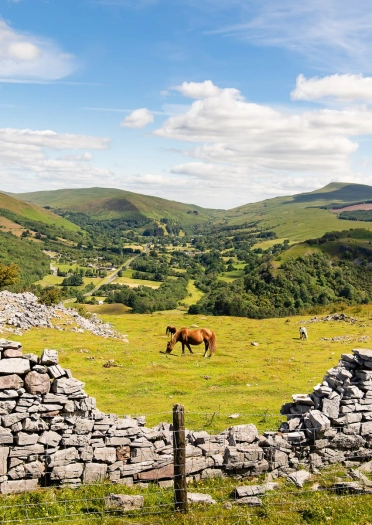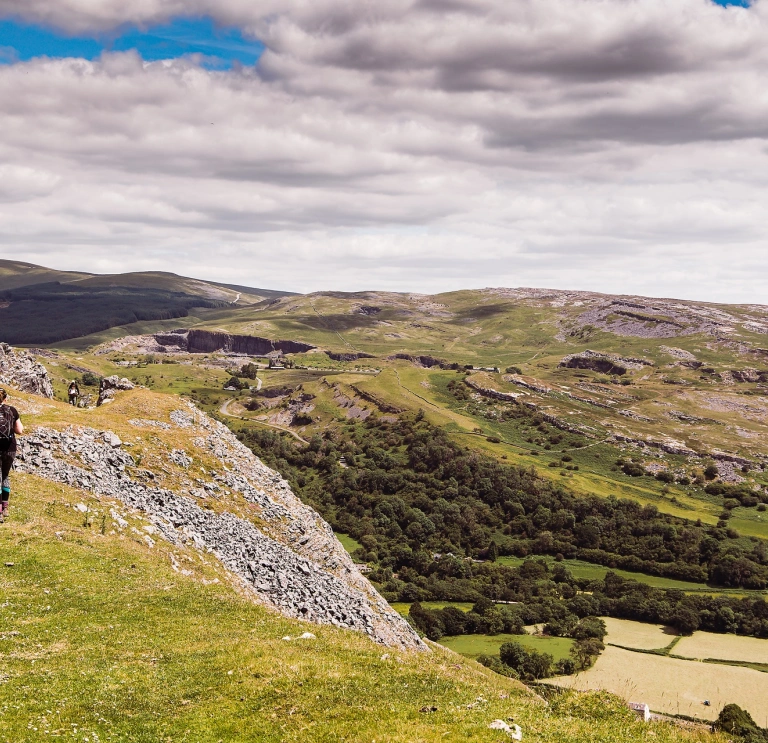Rolling green landscapes? Waterfalls? Characterful towns and a tranquil canal? They’re all here. Like a grab-bag of rural highlights, the Bannau Brycheiniog (Brecon Beacons) National Park is one of the most interesting regions in Britain.
Less than 30 miles from Cardiff and 100 miles from Birmingham, it’s easy to reach. You can drive here from central London in under three hours. There’s plenty of space – in fact, crowds are rare. Venture a little beyond the most popular trails and you’ll soon find yourself in countryside that feels utterly peaceful and remote.
The digital Brecon Beacons Pocket Guide from Brecon Beacons Tourism, includes an interactive map and information about where to see the most beautiful locations, attractions to visit, walks and activities to do and where to enjoy great places to eat and drink. It's downloadable to save on your device or print and use as a handy reference on the go.

Ancient landscapes and market towns
Carved out in the Ice Age, the mountains, hills and valleys of the Bannau Brycheiniog (Brecon Beacons) National Park have been moulded by nearly eight millennia of human activity. Many dozens of prehistoric monuments dot these weathered slopes.
There’s a rich agricultural tradition in and around the park and the region’s one of a kind towns – outdoorsy, walker friendly Crickhowell, jazzy Brecon, food-loving Abergavenny and book mad Hay-on-Wye – are genuinely refreshing.
Talgarth is a small, friendly market town with fully-restored historic working mill in the market square, which is open to the public. It has a riverside café, bakery and craft shop and just across the town square is Talgarth Visitor Centre. There's also medieval St Gwendoline’s Church positioned at the top of the town and Castell Bronllys is close by. Pwll y Wrach Nature Reserve is a great place for a walk, with an atmospheric wood and plenty of nature. The nearby Black Mountains has enjoyable trails for cycling - visit the Bannau Brycheiniog (Brecon Beacons) National Park website for suggested days out around Talgarth and the Black Mountains.The town has a number of shops, pubs and cafes, making Talgarth the perfect base from which to explore the surrounding area.


Separated from Eryri (Snowdonia) by the 40-mile-long Cambrian Mountains, its uplands stretch almost as far from west to east as Eryri National Park does from north to south, but have a quite different atmosphere. While the rocky remains of long-dead volcanoes dominate much of Eryri, the Bannau Brycheiniog (Brecon Beacons) is full of grassy moorlands, heather-clad escarpments and Old Red Sandstone peaks, softened by weather and time.
Jon Pimm, Warden, Brecon Beacons National ParkEach area of the Bannau Brycheiniog (Brecon Beacons) National Park has its own uniqueness, its own features. After working here for over ten years I’m still finding new places and seeing wonderful views I’ve not seen before.”
Mountains and moorlands
Defining the park are the highest mountains in southern Britain – the Bannau Brycheiniog (Brecon Beacons) – and the three ranges surrounding them, the Black Mountain Range in the west, Fforest Fawr and the Black Mountains to the east. At their heart is Wales’ largest expanse of open hill common, about 20 miles across. Here, Welsh mountain ponies keep the vegetation in check. The descendants of pit ponies, they’re a hardy breed. They’re said to be tougher than sheep – and less fussy eaters.
To the south, limestone pavements catch the light on half-sunny, half-cloudy days, while the west is a region of tilted rock, waterfalls and caves of such geological interest that in 2005 it was designated a UNESCO Geopark, a first for Wales. Like the rest of the park, the best way to appreciate the Fforest Fawr Geopark is on foot, by bike or on horseback, independently or with an expert guide.



Starry nights
Stay out on in the National Park overnight and, if the skies are clear, you’ll be dazzled by a dome of stars. As your eyes adjust to the immensity of it all, constellations will come into focus; time your visit carefully and you’ll have a privileged view of distant planets or meteor showers. The National Park Authority organises star gazing events to make the most of the beautiful, light-pollution-free conditions in this International Dark Sky Reserve.







